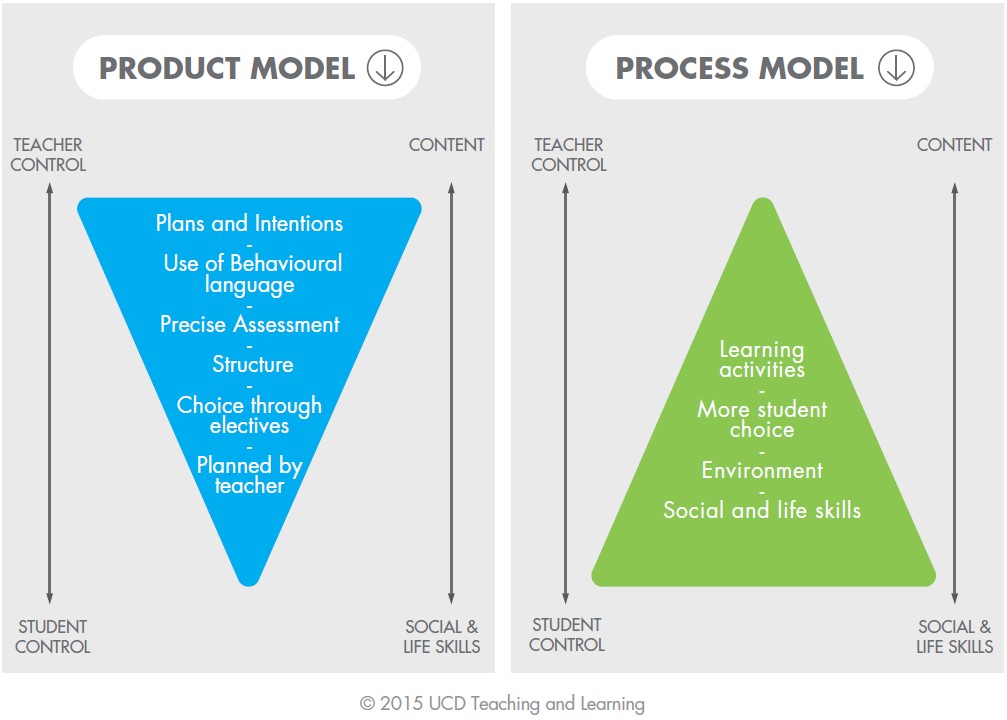Programme Vision, Values and Models
What is a vision and values statement?
In a programme design or revision process, an important early step is to consider and write a short statement on the vision and values inherent in your programme. Sometimes, this is described as a programme’s educational philosophy (Toohey, 2000; O’Neill, 2010). A vision and values statement is agreed by a programme team and sets out, for example, the programme’s:
- purpose(s)
- education and subject/discipline/professional values
- the nature of the learning environment for students
- the key approaches to teaching, learning and assessment
The main characteristics of the statement are that it:
- Is a concise and accessible paragraph(s) placed early in curriculum documentation (6-8 sentences, 1- 2 paragraphs approximately).
- Has been informed, discussed and agreed by the key stakeholders of the programme, such as graduates, current students, staff, employers, or professional bodies.
- Is written in clear language for the key audiences, including prospective and current students, staff and employers.
- Is dynamic and can be modified as the programme team and context changes over the programme’s duration.
Action
Use existing and/or gather any additional data needed to inform the statement. For example, look at the UCD Strategy, student focus group feedback, ISSE (Irish Survey of Student Engagement) results for the programme, CAO applications data, employer feedback, National Employer Surveys, Graduate Destination surveys, external examiner reports, Quality Review/Professional Accreditation reports, and professional body criteria.
Why write a vision and values statement?
The process of writing a vision and values statement will assist your programme team to:
- Dialogue and articulate your individual educational, subject, discipline, and professional values.
- Negotiate and agree to a shared vision and some common values.
The outcome of the process of writing the statement will:
- Inform a more coherent choice and sequence of programme outcomes in terms of content, teaching, learning and assessment approaches.
- Assist in the transparency of the programme’s key vision and values to students and other stakeholders.
- Assist in the planning of the programme’s organisation and structure.
Examples of Vision and Values Statements
BSc in Health Science Policy (mock programme and statement)
'This programme is aimed at students who wish to develop a career or further studies in health science policy or related disciplines (Purposes). We value and therefore encourage our students to be active, motivated, autonomous learners who have a critical and reflective approach to health science policy (Values). We aim to provide a learning environment that will encourage students to constructively challenge policies and related practices, individually or as part of a team, so they can develop their own and others’ leadership and advocacy skills. Tutorials and online discussion forums are a key element in the programme’s design (Nature of the Learning Environment). As a result of this approach to learning, the programme in particular uses teaching, learning and assessment approaches such as debates, case studies, project work, policy development/analysis, work placements, on-line group work and includes many advocacy groups and individuals in the design and delivery of the curriculum (Teaching & Learning Approaches).'
| UCD examples of individual aspects of vision and values statements | |
|---|---|
| Purpose(s) | ‘It is an academic programme but is also suited to practitioners/professionals in a related field who wish to gain a broader understanding of urban processes, policies and outcomes’. UCD MSc Urban Environment |
| Education and Subject, Discipline or Professional Values | ‘We value ambition, dedication and passion for music in all its forms: critical reflection on music, performance to the highest professional standards, and engagement with composition through analysis, reflection and the creative process’. UCD School of Music |
| Nature of the Learning Environment for Students | ‘is a flexible, innovative, negotiated learning course that takes on board the training needs of a broad spectrum of end-users by giving you the opportunity to select modules that best align with your training needs and career objectives.’ UCD MSc in Environmental Sustainability |
|
Key Approaches to Teaching, Learning and Assessment |
‘A focus on personal development and reflective learning.’ UCD Bachelor of Commerce |
Action
An Informed Vision and Values Statement is a worksheet which may be of assistance.
What curriculum models suit our context?
A key way of translating the vision into action is to research and chose curriculum models and ideas that are compatible with the vision. The Curriculum Research section provides ideas and resources for this.
Whereas an educational philosophy gives an overall statement of what we believe and value, a curriculum model gives more practical guidance on the approaches to take. Neary (2003, p. 39) highlights two commonly referred to but polarised curriculum models, one which emphasises ‘plans and intentions (The Product Model) and one which emphasises activities and effects’ (The Process Model) as illustrated in the graphic below.
Product and Process Curriculum Models

There is a range of different models that individually or collectively could suit your programme. Identifying and being consistent with these models will help support cohesion and clarity of approaches in your programme.
Learn More
O’Neill, G. (2015). Curriculum Design in Higher Education: Theory to Practice provides more details on other curriculum models.
References
- Neary, M. (2003). Curriculum concepts and research. In Curriculum studies in post-compulsory and adult education: A teacher’s and student teacher’s study guide. Cheltenham: Nelson Thornes Ltd.
- O’Neill, G. (2010) Initiating Curriculum Revision: Exploring the Practices of Educational Developers. The International Journal for Academic Development.15(1), 61-71.
- O’Neill, G. (2015). Curriculum Design in Higher Education:
- Theory to Practice, Dublin: UCD Teaching & Learning.Available from UCD Research repository at: http://researchrepository.ucd.ie/handle/10197/7137
- Toohey, S. (2000). Beliefs, values and ideologies in course design. In Designing courses for higher education. (pp.44-69).